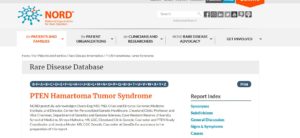
Rarediseases.org
PTEN hamartoma tumour syndrome (PHTS) refers to a spectrum of conditions that are characterised by multiple hamartomas. These conditions include:
PTEN hamartoma tumour syndrome is caused by changes (mutations) in the PTEN gene and is inherited in an autosomal dominant manner. Treatment is based on the signs and symptoms present in each person.
Symptoms of people with PHTS can vary enormously. Some patients present a large range of complaints; others barely show any symptoms at all. Among the most common symptoms are:
PHTS is caused by a germline mutation of PTEN, a tumour suppressor gene. PTEN stands for phosphatase tensin homologue. A tumour suppressor is a gene that slows down cell division, repairs damage to cell DNA and tells cells when to die, in a normal process called apoptosis. Mutations in a tumour suppressor gene often lead to cancer. The PTEN gene regulates the production of an enzyme (protein tyrosine phosphatase) that is believed to be important in stopping cell growth and starting apoptosis. Researchers believe that the PTEN gene plays a broad role in the development of human malignancies.
PHTS is inherited in an autosomal dominant pattern. Dominant genetic disorders occur when only a single copy of an abnormal gene is necessary to cause a particular disease. The abnormal gene can be inherited from either parent or can be the result of a mutated (changed) gene in the affected individual. The risk of passing the abnormal gene on from an affected parent to an offspring is 50% for each pregnancy. The risk is the same for males and females.
Given the rarity of PHTS and the wide array of symptoms, it is not very likely that a GP will immediately suspect PHTS. A set of major and minor criteria serves to determine whether someone has PHTS or not. Someone has PHTS when:
Major criteria:
Minor criteria:
Additional DNA research can confirm the diagnosis.
PHTS is a genetic disease and therefore incurable. Patients who have been diagnosed with the disease are advised to undergo regular check-ups. Patients under the age of 18 will be examined annually and have their thyroids checked by ultrasound. From the age of 40, the colon gets examined as well once every five years. Women between 25 and 75 undergo annual breast exams and from the age of 30 also gynaecological tests.






